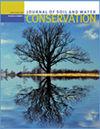利用生态监测计划收集美国西部的土壤和地貌数据
IF 2.6
4区 农林科学
Q2 ECOLOGY
引用次数: 0
摘要
生态站点信息对于解释监测数据和指导生态系统功能与服务的特定站点管理至关重要。生态信息包括土壤特性(如质地等级)、地貌特征(如坡度)和生态系统动态(如植物演替),这些都是牧场监测计划(如美国土地管理局 (BLM) 实施的评估、清查和监测 (AIM) 战略)中的重要协变量。基于实地观察,AIM 根据各主要土地资源区 (MLRA) 内独特开发的生态地点概念确定生态地点。在此,我们介绍并评估了 AIM 数据采集员在 2012 年至 2021 年期间在美国西部 14 个州确定的生态地点识别、土壤观测和地貌特征的可用性。有 31,267 个监测地块(占地块总数的 79%)确定了生态地点,29,228 个地块(占地块总数的 74%)包含在挖掘坑中检查土壤层的土壤形态描述。在大多数土壤层中都能观察到土壤质地等级(98%),而岩石碎块体积是可用数据最少的土壤属性(75%)。在对 AIM 数据采集员进行土壤剖面描述培训后,土壤数据的一致性(如在质地类别范围内观察到的粘土含量)随着时间的推移而增加。近 47% 的 AIM 地块位于陡度为 0% 至 5% 的缓坡上,以及平地/平原和丘陵/山地地貌类型上。我们证实,AIM 数据库是一个强大的土壤和地貌地理参考信息源,可用于美国西部的土地管理、土地潜力研究、土壤地理研究和土壤健康指标评估。本文章由计算机程序翻译,如有差异,请以英文原文为准。
Leveraging ecological monitoring programs to collect soil and geomorphology data across the western United States
Ecological site information is essential to interpreting monitoring data and guiding site-specific management of ecosystem functions and services. Ecological information includes soil properties (e.g., texture class), geomorphology characteristics (e.g., slope aspect), and ecosystem dynamics (e.g., plant succession), which are critical covariates in rangeland monitoring programs such as the Assessment, Inventory, and Monitoring (AIM) strategy conducted by the Bureau of Land Management (BLM). Based on field observations, AIM identifies ecological sites according to ecological site concepts uniquely developed within individual Major Land Resource Areas (MLRA). Here, we present and evaluate the availability of ecological site identification, soil observations, and geomorphology characteristics determined by AIM data collectors between 2012 and 2021 in 14 states of the western United States. There are 31,267 monitoring plots (79% of plots) with identified ecological sites and 29,228 plots (74% of plots) containing soil morphology descriptions of soil horizons examined in excavated pits. While soil texture class is observed in most soil horizons (98%), rock fragment volume is the soil property with the least data availability (75%). The consistency of soil data (e.g., clay content observations within the ranges of texture classes) increases as a function of time following guidance in soil profile description training for AIM data collectors. Nearly 47% of AIM plots are found on gentle slopes of 0% to 5% steepness and on Flat/Plain and Hill/Mountain landscape types. We confirmed that the AIM database is a robust source of georeferenced soil and geomorphology information that can be used for land management and research on land potential, soil geography, and assessment of soil health indicators across the western United States.
求助全文
通过发布文献求助,成功后即可免费获取论文全文。
去求助
来源期刊
CiteScore
4.10
自引率
2.60%
发文量
0
审稿时长
3.3 months
期刊介绍:
The Journal of Soil and Water Conservation (JSWC) is a multidisciplinary journal of natural resource conservation research, practice, policy, and perspectives. The journal has two sections: the A Section containing various departments and features, and the Research Section containing peer-reviewed research papers.

 求助内容:
求助内容: 应助结果提醒方式:
应助结果提醒方式:


